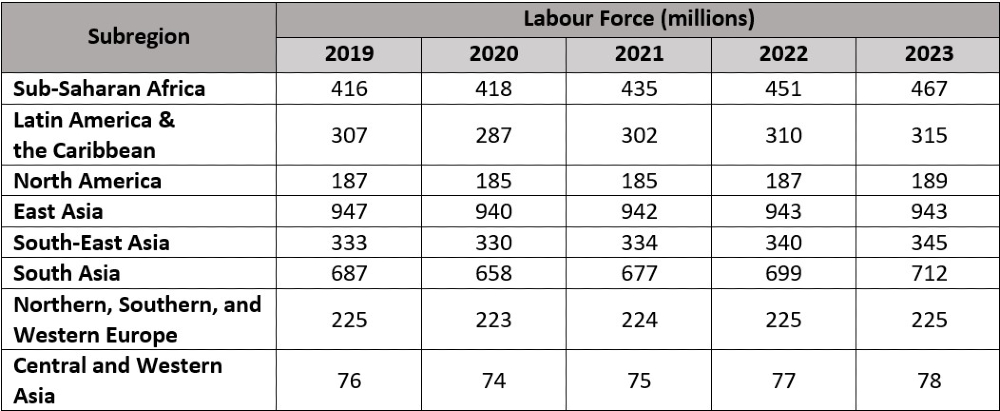
We previously took a look at the industries and new technologies that will thrive post-pandemic, as well as the current opportunities and outlooks that are driving demand for talent. It's clear that most regions and industries are still remaining strong, with many parties cooperating to ensure that job opportunities will still be available. So, where are the likely key areas where the labour market might improve?
Here's a list based on the estimates and projections of labour force in the World Employment and Social Outlook Trends 2022 report, by the International Labour Organisation:

One thing to keep in mind is that technology is among the key factors influencing the growing labour force. As noted by the World Trade Organisation in their presentation "Impact Of Technology On Labour Market Outcomes", current technological advancement has resulted in a higher relative demand for skilled workers and a lower relative demand for workers performing routine tasks.
However, don't forget that the tech and digital industries were among the hardest hit by the pandemic.
Like some other industries, the tech and digital industries experienced some eye-opening surprises as a result of the Covid-19 pandemic, but some detrimental repercussions could not be avoided. Before we recall the devastation that had befallen the tech and digital industries, let's first look at the positive effects that would last for a very long time.
Many of us have grown accustomed to our working environment as more people receive the Covid-19 vaccine, borders have opened on a national and international level, and certain things have returned to their pre-pandemic state. However, because new coronavirus variants will continue to plague us, the fight against the pandemic is far from over.

The current state of the working world is also unstable because, as noted by the Harvard Business Review (HBR), this year's level of volatility will rise as new variants continue to emerge, and many employees will experience real wage cuts as annual compensation increases lag inflation. These are all present, along with longer-term technological change, ongoing DE&I endeavours, and ongoing political upheaval and uncertainty.
The following five fundamental trends will affect workplace volatility in 2022:
Gartner HR Research reveals that 82% of employees report working environment lacks fairness. Unfairness will continue to be a hot button issue for many businesses as flexible, remote, and hybrid work models become more prevalent. There will be disputes among employees and inquiries from their superiors over who gets to work from home more frequently, who is more productive at work, and other related issues.
Many, if not most, employees in today's workplace seek flexibility. Given that flexible scheduling is associated with lower employee turnover in organisations, it is safe to assume that the opposite will result in high turnover. Employers who don't offer flexibility run the risk of losing employees to employers who do, increasing attrition risk as well.
Remote work is a great solution that has become popular for staying safe during the pandemic, but it presents employers with the conundrum of how to measure remote employee productivity. Their decision may cause friction between those who work from home and those who work in the office because, according to a Gartner November 2020 survey of nearly 3,000 managers, 64% believe that on-site employees perform better, and 75% believe that on-site employees are more likely to be promoted.
According to HBR, more than 90% of employees intend to use a hybrid working model for their knowledge workers in 2022. However, nearly halfway through the year, some companies have stated that they want their employees back in the office. As many as 58% of companies polled by Teamlease believe that work will be done entirely in-office in the future. Employees and management may clash as they adjust to the new working model.
In 2022, organisations will implement new measures to assess their employees' mental, physical, and financial health, as mentioned by HBR. Following the pandemic, many businesses increased their wellness support. For example, a Gartner 2020 survey of 52 HR executives discovered:
Thus, employers must understand whether employees are taking advantage of the benefits and whether any of the benefits have assisted them in improving their well-being.
When coping with the new working environment that follows the pandemic, various viewpoints and approaches are available out there. Fortunately, a number of corporate leaders are voicing their views on the subject and wanting to assist employees in dealing with the new challenges. Check out some of their responses below:

“CIOs and IT leaders are trying to wrestle with, you know, 'What's the level of flexibility I give my workforce here? Can I let them have an Apple Watch Connect?' Well, you probably should, because this generation considers that part of their productivity stack – a part of how they stay connected.”
He continued, “So you take all those conditions, and the data is clear. IT leaders are now going to have to manage this extreme flexibility and how they allow their workforce to connect and do their jobs. In fact, what I find compelling about the data is that it suggests they'll sacrifice promotions and pay and positioning for flexibility.”

"For many companies, data will be part of day-to-day work and overarching strategy, if it isn’t already. This is especially true at Healr Solutions, which uses data to create solutions for biopharmaceutical supply chains. As we progress to the future, work will be heavily dependent on making decisions based on large datasets."
He continued, "At Target, we use data-driven tools to support quicker, more effective decision making. The way of the future is using that information to improve speed and quality of service to meet guest expectations."

“Bots offer a particular opportunity for highly regulated industries like health care that have codified activities. A bot can bring a quick solution, reducing the risk of human error and freeing up time for researchers.” She continued, “Amgen is thinking about existing skills and determining where gaps are, with an emphasis on involving employees in solutions.
She continued, “This includes explaining why changes are made and how more and new technology will benefit employees by helping them develop new skills and free up time. People are worried they’ll be replaced by technology and lose their jobs. This can be quickly addressed once individuals understand how these tools will help them perform better and more efficiently.”

“If you want to predict the future, you don’t look at big companies or older companies – you look at young companies, especially for [work] culture. Airbnb’s 'work from anywhere' model isn’t just forward-thinking, but unique in its approach to salaries, as almost everyone with flexible work policies still ties employees’ pay to their locations.”
He added, “The most talented people aren’t in San Francisco anymore, and they’re not here in New York. The most talented people are everywhere now – and if I need engineers, designers, product managers, or marketers, they’re getting so distributed that if you limit your talent pool to community radius, you’re probably at a disadvantage.”
Due to the pandemic, organisations from all sectors have changed how they operate, who they hire, what kinds of jobs they offer, and other aspects of their business. In just two years, many aspects of how people work have changed drastically. To avoid falling behind and maintain their competitiveness in the labour market, both employers and employees must quickly adapt.
Just as the World Economic Forum and Boston Consulting Group reported on some potential outlooks for the workplace of the future. These include elements like the rapidly expanding global workforce, extensive automation of employee tasks, a higher percentage of the workforce moving to remote positions and entrepreneurial endeavours, and a higher proportion of high-skill areas moving into high-skilled jobs.
What can employers do to help employees get ready? Making a workforce that is prepared for the future is the key. The BCG recommended the following actions for businesses to take, in order to meet the challenges of upskilling and future-proof their workforce while also ensuring employees are prepared to face any work challenges that come, especially in the future of work:

The pandemic has changed how people work, live, receive healthcare, and shop and these changes will boost demand for tech and digital occupations. Many people will be curious as to whether the situation will change back to how it was before the pandemic. But each of us needs to keep moving forward and take the necessary actions to adapt to what is happening right now and in the future in this quickly changing, constantly evolving world.
The ongoing pandemic and economic uncertainty make the future unpredictable. In some industries, there may be more open positions, while in others, there may be more layoffs. Employees may reduce working hours or work from home full-time, but it is also possible to do the opposite. There are a lot of potential changes, but here are some predicted by Gartner for the workplace over the next ten years:
If you're looking for more about the future of a post-pandemic world, why not check out our other article coverages:
1) Pandemic-Rebound Part 1: Which Industries/New Technologies Will Thrive And See A Rise In Hiring?
2) Pandemic-Rebound Part 2: What Are The General Outlooks And Opportunities From Around The World?